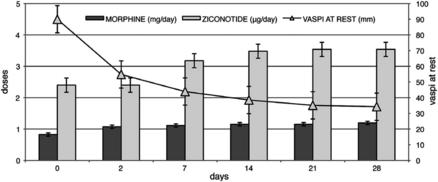Pain Management
Cancer Pain Management
Intrathecal combination of ziconotide and morphine for refractory cancer pain: A rapidly acting and effective choice
Alicino I, Giglio M, Manca F, et al (Univ of Bari, Italy) Pain 153:245-249, 2012§
Evidence Ranking
• B
Expert Rating
• 2
Abstract
Ziconotide is a nonopioid intrathecal analgesic drug used to manage moderate to severe chronic pain. The aim of this work is to assess the safety and efficacy of intrathecal (IT) combination of ziconotide and morphine in malignant pain refractory to high doses of oral opioids. Patients with malignant pain refractory to high oral opioids doses with a mean visual analogue scale of pain intensity (VASPI) score of ≥70 mm were enrolled. An IT combination therapy was administered: Ziconotide was started at a dose of 2.4 μg/day, followed by increases of 1.2 μg/day at intervals of at least 7 days, and an initial IT daily dose of morphine was calculated based on its oral daily dose. Percentage change in VASPI scores from baseline was calculated at 2 days, at 7 days, and weekly until the first 28 days. The mean percentage change of VASPI score from baseline was used for efficacy assessment. Safety was monitored based on adverse events and routine laboratory values. Twenty patients were enrolled, with a mean daily VASPI score at rest of 90 ± 7. All had a disseminated cancer with bone metastases involving the spine. The percentage changes in VASPI mean scores from baseline to 2 days, 7 days, and 28 days were 39 ± 13% (95% confidence interval [CI] = 13.61–64.49, P < .001), 51 ± 12% (95% CI = 27.56–74.56, P < .001), and 62 ± 13% (95% CI = 36.03–87.89%, P < .001), respectively. Four patients experienced mild adverse events related to the study drugs. In conclusion, an IT combination of low doses of ziconotide and morphine allows safe and rapid control of oral opioid–refractory malignant pain (Fig 1).

Full access? Get Clinical Tree




